Chapter 15 Areas of Parallelograms and Triangles RD Sharma Solutions Exercise 15.3 Class 9 Maths
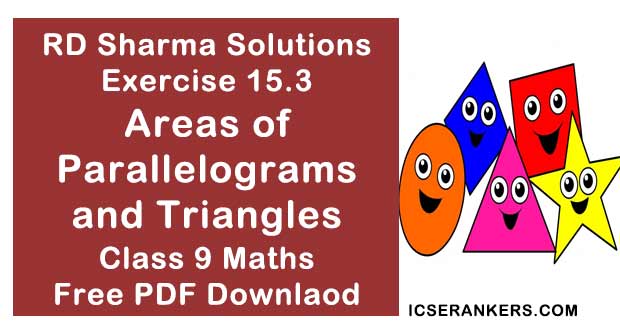
Chapter Name | RD Sharma Chapter 15 Areas of Parallelograms and Triangles Exercise 15.3 |
Book Name | RD Sharma Mathematics for Class 10 |
Other Exercises |
|
Related Study | NCERT Solutions for Class 10 Maths |
Exercise 15.3 Solutions
1. In the below figure, compute the area of quadrilateral ABCD.
Given that,
DC = 17 cm
AD = 9cm and BC = 8cm
In ΔBCD we have

2. In the below figure, PQRS is a square and T and U are respectively, the mid - points of PS and QR. Find the area of ΔOTS if PQ = 8 cm.

Solution
From the figure
T and U are the midpoints of PS and QR respectively.
∴ TU || PQ
⇒ TO || PQ
Thus, in ΔPQS, T is the midpoint of PS and TO || PQ

∴ TU || PQ
⇒ TO || PQ
Thus, in ΔPQS, T is the midpoint of PS and TO || PQ

3. Compute the area of trapezium PQRS is Fig. below.

Solution
We have

4. In the below fig. ∠AOB = 90°, AC = BC, OA = 12 cm and OC = 6.5 cm. Find the area of ΔAOB.

Solution
Since, the midpoint of the hypotenuse of a right triangle is equidistant from the vertices
∴ CA = CB = OC
⇒ CA = CB = 6.5 cm
∴ CA = CB = OC
⇒ CA = CB = 6.5 cm
⇒ AB = 13 cm
In a right angle triangle OAB, we have

and distance between AB and DC is 4cm. Find the value of x and area of trapezium ABCD.
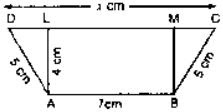
Solution

6. In the below fig. OCDE is a rectangle inscribed in a quadrant of a circle of radius 10 cm. If OE = 2√5, find the area of the rectangle.

Solution
Given OD = 10 cm and OE = 2√5 cm
By using Pythagoras theorem


Solution
Given : ABCD is a trapezium with AB || DC
To prove : ar(ΔAOD) = ar (BOC)
Proof :
To prove : ar(ΔAOD) = ar (BOC)
Proof :
Since ΔADC and ΔBDC are on the same base DC and between same parallels AB and DC

8. In the given below fig. ABCD, ABFE and CDEF are parallelograms. Prove that ar(ΔADE) = ar(ΔBCF) .

Solution
Given that,
ABCD is a parallelogram ⇒ AD = BC
CDEF is a parallelogram ⇒ DE = CF
ABFE is a parallelogram ⇒ AE = BF
CDEF is a parallelogram ⇒ DE = CF
ABFE is a parallelogram ⇒ AE = BF
Thus, in Δs ADE and BCF, we have
AD = BC, DE = CF and AE = BF
So, by SSS criterion of congruence, we have
ΔADE ≅ ΔABCF
ΔADE ≅ ΔABCF
∴ ar(ΔADE) = ar(BCF)
9. Diagonals AC and BD of a quadrilateral ABCD intersect each other at P. Show that:
ar(∆APB) × ar(∆CPD) = ar(∆APD) × ar (∆BPC)
Solution

10. In the below Fig, ABC and ABD are two triangles on the base AB. If line segment CD is bisected by AB at O, show that ar (ΔABC) = ar (ΔABD)

Solution
Given that CD is bisected at O by AB
To prove : ar(ΔABC) = ar(ΔABD)
Construction : Draw CP ⊥ AB and DQ ⊥ AB
Construction : Draw CP ⊥ AB and DQ ⊥ AB
Proof :

11. If P is any point in the interior of a parallelogram ABCD, then prove that area of the triangle APB is less than half the area of parallelogram.
Solution
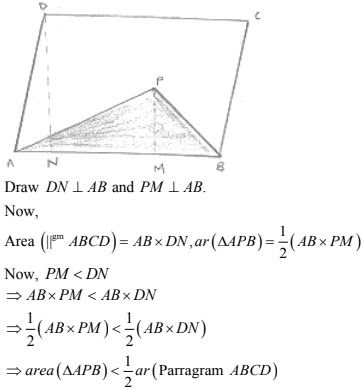
12. If AD is a median of a triangle ABC, then prove that triangles ADB and ADC are equal in area. If G is the mid - point of median AD, prove that ar(ΔBGC) = 2 ar(ΔAGC).
Solution

Solution

Given that,
In ΔABC, BD = 2DC
To prove : ar(ΔABD) = 2ar (ΔADC)
Construction : Take a point E on BD such that BE = ED
Proof : Since, BE = ED and BD = 2DC
Then, BE = ED = DC
To prove : ar(ΔABD) = 2ar (ΔADC)
Construction : Take a point E on BD such that BE = ED
Proof : Since, BE = ED and BD = 2DC
Then, BE = ED = DC
We know that median of Δle divides it into equal Δles .
∴ In ΔABD, AE is a median
∴ In ΔABD, AE is a median
Then, area (ΔABD) = 2ar(ΔAED) ...(i)
In ΔAEC, AD is a median Then area (ΔAED) = area (ΔADC) ...(ii)
Compare equation (i) and (ii)
Area (ΔABD) = 2ar(ΔADC).
Compare equation (i) and (ii)
Area (ΔABD) = 2ar(ΔADC).
14. ABCD is a parallelogram whose diagonals intersect at O. If P is any point on BO, Prove that:
(i) ar (ΔADO) = ar(ΔCDO)
(ii) ar(ΔABP) = ar(ΔCBP)
(ii) ar(ΔABP) = ar(ΔCBP)
Solution

Given that ABCD is a parallelogram
To prove : (i) ar(ΔADO) = ar(ΔCDO)
(ii) ar(ΔABP) = ar(ΔCBP)
Proof: We know that, diagonals of a parallelogram bisect each other
(ii) ar(ΔABP) = ar(ΔCBP)
Proof: We know that, diagonals of a parallelogram bisect each other
∴ AO = OC and BO = OD
(i) In ΔDAC, since DO is a median
Then area (ΔADO) = area (ΔCDO)
(ii) In ΔBAC, Since BO is a median
Then; area (ΔBAO) = area (ΔBCO) ...(1)
In a ΔPAC, Since PO is a median
In a ΔPAC, Since PO is a median
Then, area (ΔPAO) = area (ΔPCO) ...(2)
Subtract equation (2) from equation (1)
⇒ area(ΔBAO) - ar(ΔPAO) = ar(ΔBCO) - area(ΔPCO) ⇒ Area (ΔABP) = Area of ΔCBP
15.ABCD is a parallelogram in which BC is produced to E such that CE = BC. AE intersects CD at F.
(i) Prove that ar(ΔADF) = ar(ΔECF)
(ii) If the area of ΔDFB = 3 cm2, find the area of ||gm ABCD.
(ii) If the area of ΔDFB = 3 cm2, find the area of ||gm ABCD.
Solution
In triangles ADF and ECF, we have
∠ADF = ∠ECF [Alternative interior angles, Since AD || BE]
AD = EC [Since AD = BC = CE]
And ∠DFA = ∠CFA [vertically opposite angles]
AD = EC [Since AD = BC = CE]
And ∠DFA = ∠CFA [vertically opposite angles]
So, by AAS congruence criterion, we have
ΔADF ≅ ΔECF
⇒ area (ΔADF) = area (ΔECF) and DF = CF.
Now, DF = CF
⇒ BF is a median in ΔBCD
⇒ area (ΔBCD) = 2ar(ΔBDF)
⇒ area (ΔBCD) = 2×3 cm2 = 6cm2
⇒ area (ΔBCD) = 2×3 cm2 = 6cm2
Hence, ar(||gm ABCD) = 2ar(ΔBCD) = 2 × 6 cm2 = 12cm2

16. ABCD is a parallelogram whose diagonals AC and BD intersect at O. A line through O intersects AB at P and DC at Q. Prove that ar(ΔPOA) = ar(ΔQOC).
Solution

17. ABCD is a parallelogram. E is a point on BA such that BE = 2 EA and F is a point on DC such that DF = 2 FC. Prove that AE CF is a parallelogram whose area is one third of the area of parallelogram ABCD.
Solution

18. In a ΔABC, P and Q are respectively the mid - points of AB and BC and R is the mid - point of AP. Prove that :
(i) ar(ΔPBQ) = ar (ΔARC)
(ii) ar (ΔPRQ) = 1/2 ar(ΔARC)
(iii) ar(ΔRQC) = 3/8 ar (ΔABC).
(ii) ar (ΔPRQ) = 1/2 ar(ΔARC)
(iii) ar(ΔRQC) = 3/8 ar (ΔABC).
Solution

19. ABCD is a parallelogram, G is the point on AB such that AG = 2 GB, E is a point of DC such that CE = 2DE and F is the point of BC such that BF = 2FC. Prove that :
(i) ar(ADEG) = ar(GBCE)
(ii) ar(ΔEGB) = 1/6 ar(ABCD)
(iii) ar(ΔEFC) = 1/2 ar(ΔEBF)
(iv) ar(ΔEBG) = ar(ΔEFC)
(v) Find what portion of the area of parallelogram is the area of ΔEFG.
(i) ar(ADEG) = ar(GBCE)
(ii) ar(ΔEGB) = 1/6 ar(ABCD)
(iii) ar(ΔEFC) = 1/2 ar(ΔEBF)
(iv) ar(ΔEBG) = ar(ΔEFC)
(v) Find what portion of the area of parallelogram is the area of ΔEFG.
Solution


20. In Fig. below, CD || AE and CY || BA.
(i) Name a triangle equal in area of ΔCBX
(ii) Prove that ar (ΔZDE) = ar(ΔCZA)
(iii) Prove that ar(BCZY) = ar(ΔEDZ)
(iii) Prove that ar(BCZY) = ar(ΔEDZ)

Since, ΔBCA and ΔBYA are on the same base BA and between same parallels BA and CY
Then area (ΔBCA) = ar(ΔBYA)
⇒ ar(ΔCBX) + ar(ΔBXA) = ar(ΔBXA) + ar(ΔAXY)
⇒ ar(ΔCBX) = ar(ΔAXY) ...(1)
Since, ΔACE and ΔADE are on the same base AE and between same parallels CD and AE
Then, ar(ΔACE) = ar(ΔADE)
⇒ ar(ΔCLA) + ar(ΔAZE) = ar(ΔAZE) + ar(ΔDZE)
⇒ ar(ΔCBX) + ar(ΔBXA) = ar(ΔBXA) + ar(ΔAXY)
⇒ ar(ΔCBX) = ar(ΔAXY) ...(1)
Since, ΔACE and ΔADE are on the same base AE and between same parallels CD and AE
Then, ar(ΔACE) = ar(ΔADE)
⇒ ar(ΔCLA) + ar(ΔAZE) = ar(ΔAZE) + ar(ΔDZE)
⇒ ar(ΔCZA) = (ΔDZE) ...(2)
Since ΔCBY and ΔCAY are on the same base CY and between same parallels
BA and CY
Since ΔCBY and ΔCAY are on the same base CY and between same parallels
BA and CY
Then ar(ΔCBY) = ar(ΔCAY)
Adding ar(ΔCYG) on both sides, we get
Adding ar(ΔCYG) on both sides, we get
⇒ ar(ΔCBX) + ar(ΔCYZ) = ar(ΔCAY) + ar(ΔCYZ)
⇒ ar(BCZX) = ar(ΔCZA) ...(3)
Compare equation (2) and (3)
ar(BCZY) = ar(ΔDZE)
⇒ ar(BCZX) = ar(ΔCZA) ...(3)
Compare equation (2) and (3)
ar(BCZY) = ar(ΔDZE)
21. In below fig., PSDA is a parallelogram in which PQ = QR = RS and AP || BQ || CR. Prove that ar(ΔPQE) = ar(ΔCFD).

Solution
Given that PSDA is a parallelogram
Since, AP || BQ || CR || DS and AD|| PS
∴ PQ = CD ...(i)
In ΔBED, C is the midpoint of BD and CF || BE
∴ PQ = CD ...(i)
In ΔBED, C is the midpoint of BD and CF || BE
∴ F is the midpoint of ED
⇒ EF = PE
Similarly
EF = PE
∴ PE = FD ...(2)
In ΔSPQE and CFD, we have
In ΔSPQE and CFD, we have
PE = FD [Alternative angles]
∠EDQ = ∠FDC,
And PQ = CD
∠EDQ = ∠FDC,
And PQ = CD
So, by SAS congruence criterion, we have ΔPQE ≅ ΔDCF.
12. In the below fig. ABCD is a trapezium in which AB || DC and DC = 40 cm and AB = 60 cm. If X and Y are respectively, the mid - points of AD and BC, prove that :
(i) XY = 50 cm
(ii) DCXY is a trapezium
(iii) ar(trap. DCYX) = 9/11 ar(trap. XYBA)
Solution

23. In Fig. below, ABC and BDE are two equilateral triangles such that D is the mid - point of BC. AE intersects BC in F. Prove that

(ii) ar(ΔBDE) = 1/2 ar(ΔBAE)
(iii) ar(ΔBEF) = ar(ΔAFD).
(iv) ar(ΔABC) = ar(ΔBEC)
(v) ar(ΔFED) = 1/8 ar(ΔAFC)
(vi) ar(ΔBFE) = 2ar(ΔEFD)
(v) ar(ΔFED) = 1/8 ar(ΔAFC)
(vi) ar(ΔBFE) = 2ar(ΔEFD)
Solution
Given that,
ABC and BDE are two equilateral triangles.
Let AB = BC = CA = x. Then BD = x/2 = DE = BE

(ii) It is given that triangles ABC and BED are equilateral triangles
∠ACB = ∠DBE = 60°
⇒ BE || AC (Since alternative angles are equal)
Triangles BAF and BEC are on the same base
∠ACB = ∠DBE = 60°
⇒ BE || AC (Since alternative angles are equal)
Triangles BAF and BEC are on the same base
BE and between the same parallel BE and AC
∴ ar(ΔBAE) = area(ΔBEC)
⇒ ar(ΔBAE) = 2ar(ΔBDE)
[∵ED is a median of ΔEBC; ar(ΔBEC) = 2ar(ΔBDE)]
⇒ area(ΔBDE) = 1/2 ar(ΔBAE)
⇒ ar(ΔBAE) = 2ar(ΔBDE)
[∵ED is a median of ΔEBC; ar(ΔBEC) = 2ar(ΔBDE)]
⇒ area(ΔBDE) = 1/2 ar(ΔBAE)
(iii) Since ΔABC and ΔBDE are equilateral triangles
∴ ∠ABC = 60° and ∠BDE = 60°
∠ ABC = ∠BDE
∠ ABC = ∠BDE
⇒ AB || DE (Since alternative angles are equal)
Triangles BED and AED are on the same base ED and between the same parallels AB and DE.
Triangles BED and AED are on the same base ED and between the same parallels AB and DE.
∴ ar(ΔBED) = area(ΔAED)
⇒ ar(ΔBED) - area (ΔEFD) = area (AED) - area (ΔEFD)
⇒ ar(BEF) = ar(ΔAFD).
⇒ ar(ΔBED) - area (ΔEFD) = area (AED) - area (ΔEFD)
⇒ ar(BEF) = ar(ΔAFD).
(iv) Since ED is the median of ΔBEC
∴ area(ΔBEC) = 2ar(ΔBDE)
⇒ ar(ΔBEC) = 2 × 1/4 ar(ΔABC) [from (i)]
⇒ ar(ΔBEC) = 2 × 1/4 ar(ΔABC) [from (i)]
⇒ ar(ΔBEC) = 1/2 area(ΔABC)
⇒ area(ΔABC) = 2area (ΔBEC)
⇒ area(ΔABC) = 2area (ΔBEC)
(v) Let h be height of vertex E, corresponding to the side BD on triangle BDE
Let H be the height of the vertex A corresponding to the side BC in triangle ABC
From part (i)
From part (i)

24. D is the mid - point of side BC of ΔABC and E is the mid - point of BD. If O is the mid - point of AE, prove that ar(ΔBOE) = 1/8 ar(ΔABC).
Solution

25. In the below fig. X and Y are the mid - points of AC and AB respectively, QP || BC and CYQ and BXP are straight lines. Prove that ar(ΔABP) = ar(ΔACQ).


We observe that the quadrilateral XYAP and XY AQ are on the same base XY and between the same parallel XY and PQ .

(ii) Since, ΔPEA and ΔQFD stand on the same base PE and FQ lie between the same parallels EQ and AD

Solution
Since x and y are the midpoint AC and AB respectively
∴ XY || BC
Clearly, triangles BYC and BXC are on the same base BC and between the same parallels XY and BC

We observe that the quadrilateral XYAP and XY AQ are on the same base XY and between the same parallel XY and PQ .
∴ area (quad XY AP) = ar(quad XYPA)
Adding (i) and (ii) , we get
Adding (i) and (ii) , we get
ar(ΔBXY) + ar(quadXYAP) = ar(CXY) + ar(quad XYQA)
⇒ ar(ΔABP) = ar(ΔACQ)
⇒ ar(ΔABP) = ar(ΔACQ)
26. In the below fig. ABCD and AEFD are two parallelograms. Prove that
(i) PE = FQ
(ii) ar(ΔAPE) : ar(ΔPFA) = ar(ΔQFD) : ar(ΔPFD)
(iii) ar(ΔPEA) = ar(ΔQFD)

(ii) ar(ΔAPE) : ar(ΔPFA) = ar(ΔQFD) : ar(ΔPFD)
(iii) ar(ΔPEA) = ar(ΔQFD)

Solution
Given that, ABCD and AEFD are two parallelograms
To prove : (i) PE = FQ


27. In the below figure, ABCD is parallelogram. O is any point on AC. PQ || AB and LM || AD. Prove that ar(||gm DLOP) = ar(||gm BMOQ)
Solution
Since, a diagonal of a parallelogram divides it into two triangles of equal area
∴ area (ΔADC) = area(ΔABC)

Since, AO and OC are diagonals of parallelograms AMOP and OQCL respectively.

Since, AO and OC are diagonals of parallelograms AMOP and OQCL respectively.

28. In a ΔABC, if L and M are points on AB and AC respectively such that LM || BC. Prove that :
(i) ar(ΔLCM) = ar(ΔLBM)
(ii) ar(ΔLBC) = ar(ΔMBC)
(iii) ar(ΔABM) = ar(ΔACL)
(iv) ar(ΔLOB) = ar(ΔMOC)
(ii) ar(ΔLBC) = ar(ΔMBC)
(iii) ar(ΔABM) = ar(ΔACL)
(iv) ar(ΔLOB) = ar(ΔMOC)
Solution
(i) Clearly Triangles LMB and LMC are on the same base LM and between the same parallels LM and BC.
∴ ar(ΔLMB) = ar(ΔLMC) ...(i)
∴ ar(ΔLMB) = ar(ΔLMC) ...(i)
(ii) We observe that triangles LBC and MBC area on the same base BC and between the same parallels LM and BC
∴ arc ΔLBC = ar(ΔMBC) ...(ii)
ar(ΔLMB) = ar(ΔLMC) [from (i)]
⇒ ar(ΔALM) + ar(ΔLMB) = ar(ΔALM) + ar(ΔLMC)
⇒ ar(ΔABM) = ar(ΔACL)
⇒ ar(ΔALM) + ar(ΔLMB) = ar(ΔALM) + ar(ΔLMC)
⇒ ar(ΔABM) = ar(ΔACL)
(iv) We have
ar(ΔCBC) = ar(ΔMBC) ∴ [from (i)]
⇒ ar(ΔLBC) = ar(ΔBOC) = ar(ΔMBC) - ar(ΔBOC)
⇒ ar(ΔLBC) = ar(ΔBOC) = ar(ΔMBC) - ar(ΔBOC)
⇒ ar(ΔLOB) = ar(ΔMOC)
29. In the below fig. D and E are two points on BC such that BD = DE = EC. Show that ar(ΔABD) = ar(ΔADE) = ar(ΔAEC).

Solution
Draw a line through A parallel to BC

We observe that the triangles ABD and AEC are on the equal bases and between the same parallels C and BC. Therefore, Their areas are equal.
Hence, ar(ΔABD) = ar(ΔADE) = ar(ΔACDE)
30. If below fig. ABC is a right triangle right angled at A, BCED, ACFG and ABMN are squares on the sides BC, CA and AB respectively. Line segment AX ⊥ DE meets BC at Y.
Show that:
(i) ΔMBC ≅ ΔABD
(ii) ar(BYXD) = 2 ar(ΔMBC)
(iii) ar(BYXD) = ar(ΔABMN)
(iv) ΔFCB ≅ ΔACE
(v) ar(CYXE) = 2 ar(ΔFCB)
(vi) ar(CYXE) = ar(ACFG)
(vii) ar (BCED) = ar(ABMN) + ar(ACFG)
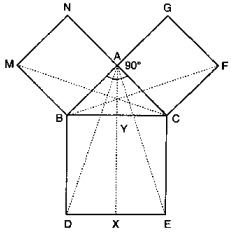
Solution
(i) In ΔMBC and ΔABD, we have
MB = AB
BC = BD
And ∠MBC = ∠ABD
[∵ ∠MBC and ∠ABC are obtained by adding ∠ABC to a right angle]
So, by SAS congruence criterion, We have
ΔMBC ≅ ΔABD
⇒ ar(ΔMBC) = ar(ΔABD) ...(1)
(ii) Clearly, ΔABC and BYXD are on the same base BD and between the same parallels AX and BD
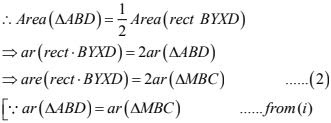
(iii) Since triangle M. BC and square MBAN are on the same Base MB and between the same parallels MB and NC
∴ 2ar(ΔMBC) = ar(ΔMBAN) ...(3)
From (2) and (3) we have
From (2) and (3) we have
ar(sq. MBAN) = ar(rect BYXD).
(iv) In triangles FCB and ACE we have
FC = AC
CB = CF
And ∠FCB = ∠ACE
[∵ ∠FCB and ∠ACE are obtained by adding ∠ACB to a right angle]
So, by SAS congruence criterion, we have
ΔFCB ≅ ΔACE
(v) We have
ΔFCB ≅ ΔACE
⇒ ar(ΔFCB) = ar(ΔECA)
⇒ ar(ΔFCB) = ar(ΔECA)
Clearly, ΔACE and rectangle CYXE are on the same base CE and between the same parallels CE and AX
∴ 2ar (ΔACE) = ar(CYXE)
(vi) Clearly, ΔFCB and rectangle FCAG are on the same base FC and between the same parallels FC and BG
∴ 2ar(ΔFCB) = ar(FCAG)
From (4) and (5), we get
Area (CYXE) = ar(ACFG)
(vii) Applying Pythagoras theorem in ΔACB, we have


